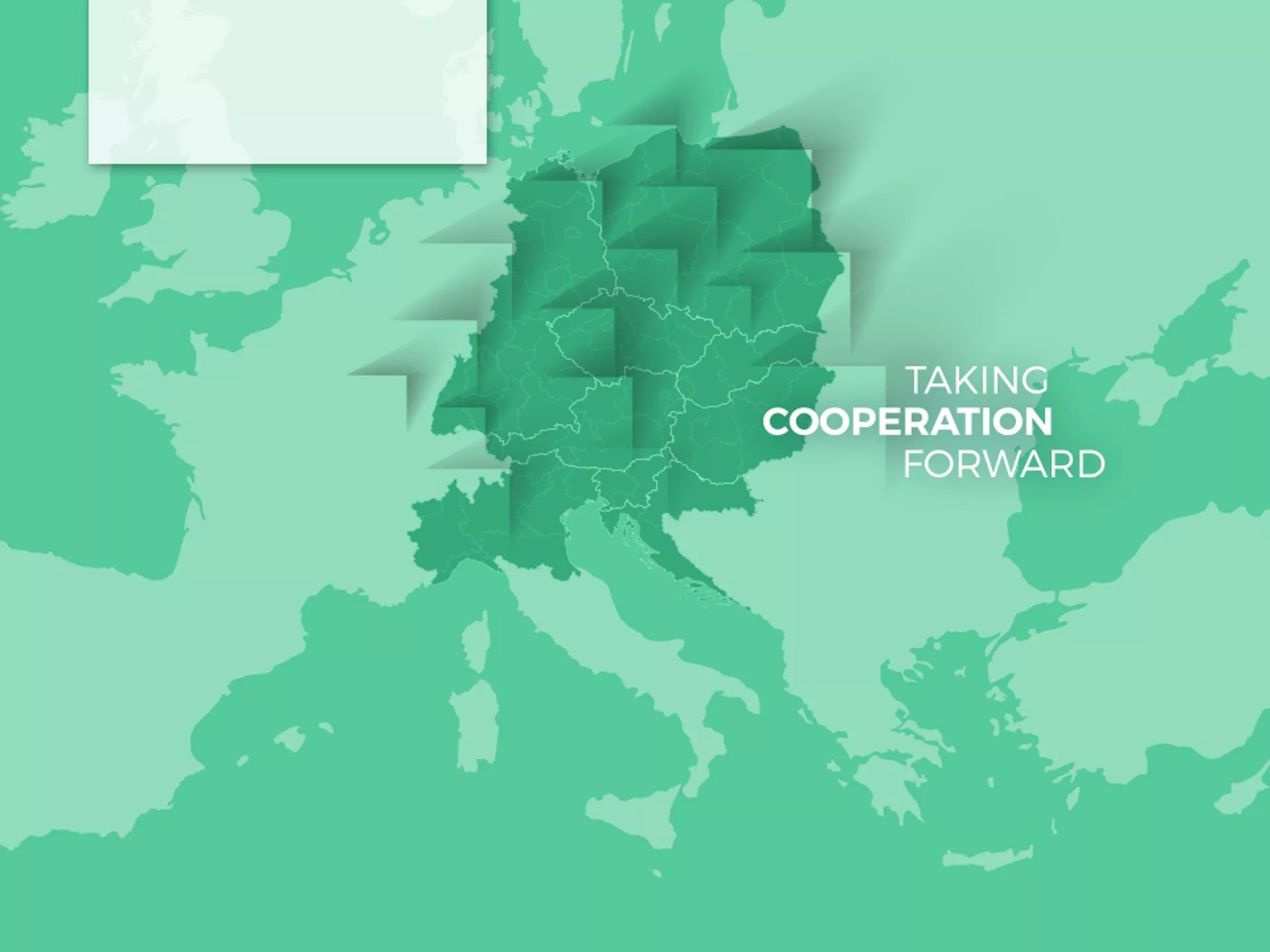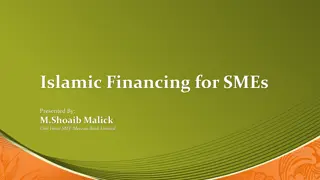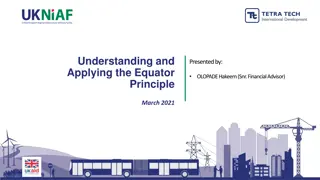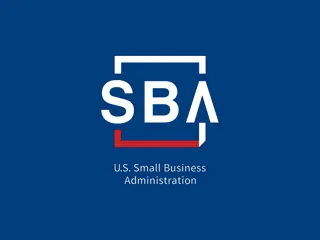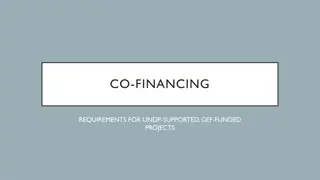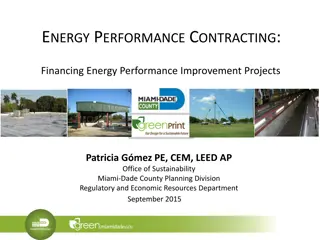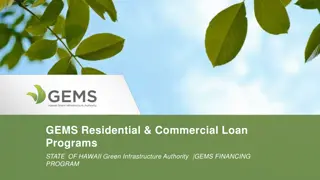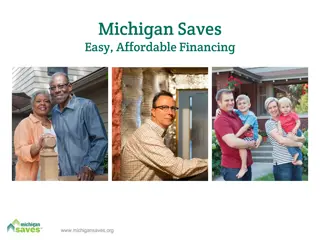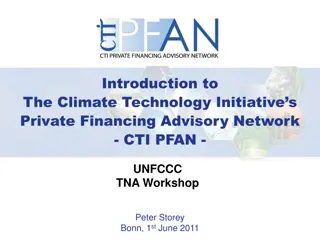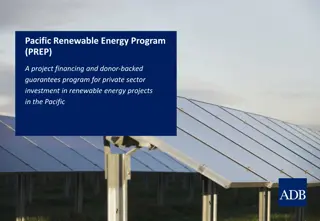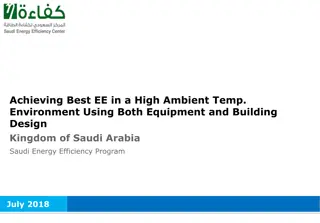Financing Energy Efficiency Projects: Overview of Financial Sources
This training block focuses on providing local authorities with free tuition on implementing Nearly Zero Energy Building (NZEB) renovation activities in schools. It covers different financial sources for energy efficiency projects, comparative analysis, and available financing schemes. The content highlights challenges with own budget financing and traditional project financing in cities and municipalities.
Download Presentation

Please find below an Image/Link to download the presentation.
The content on the website is provided AS IS for your information and personal use only. It may not be sold, licensed, or shared on other websites without obtaining consent from the author. Download presentation by click this link. If you encounter any issues during the download, it is possible that the publisher has removed the file from their server.
E N D
Presentation Transcript
Block 4: Financing of energy efficiency projects 4.1 Financial sources in general D.T4.4.1 e-learning course 1 TAKING COOPERATION FORWARD FEEDSCHOOLS, by HEP ESCO
BLOCK 4: FINANCING OF ENERGY EFFICIENCY PROJECTS This block is part of a training package developed to provide local authorities with free tuition that may inspire and help them in adopting new technical and financial solutions to implement nearly Zero Energy Building (NZEB) renovation activities in schools. After an Overview of possible financial sources for EE projects, this block will introduce Financial sources for EE projects, Comparative analysis of possible financial sources and Available and acceptable financing shemes (Country analysis). Beginner: No special knowledge is needed 2 TAKING COOPERATION FORWARD
BLOCK 4: FINANCING OF ENERGY EFFICIENCY PROJECTS Learning Objective: At the end of this block attendees will be provided with basic concepts to understand the issue of Financial sources for EE projects, Comparative analysis of possible financial sources and Country analysis. 4.1.4 Self assessment test 4.1.2 Comparative analysis of possible financial sources 4.1.3 Conclusion 4.1.1 Overview of possible financial sources for EE projects 4.1 Financial sources in general 3 TAKING COOPERATION FORWARD
BLOCK 4: FINANCING OF ENERGY EFFICIENCY PROJECTS 4.1 Financial sources in general 4.1Objective After an Overview of possible financial sources for EE projects, this block will introduce Financial sources for EE projects, Comparative analysis of possible financial sources and Available and acceptable financing shemes (Country analysis) 4 TAKING COOPERATION FORWARD
4.1.1 OVERVIEW OF POSSIBLE FINANCIAL SOURCES FOR EE PROJECTS Own (budget) financing Traditional financing of projects in cities and municipalities relies dominantly on the use of own budget Challenges: insufficient revenue base with which to fund projects dependence on revenue transfers from regional or national governments (risk) This introduces further uncertainties and makes commitment to multi- year programs of capital expenditures more difficult 5 TAKING COOPERATION FORWARD
4.1.1 OVERVIEW OF POSSIBLE FINANCIAL SOURCES FOR EE PROJECTS Credit (loan) financing National governments often impose limits on borrowing by municipalities to prevent them getting into financial difficulties and lead to uncontrolled increase of the public debt > debt limitations EE projects are not typical capital expenditure projects that can be readily assessed and approved by higher authorities EE projects, with relatively low public profiles, are likely to have a lower priority than other pressing or mandated needs Soft loans are dedicated credit lines for EE measures extended to end users at preferential terms in terms of maturity and/or interest rates - often provided by national or international development banks (e.g. EIB, EBRD) and further distributed to designated markets through regional partner retail banks . 6 TAKING COOPERATION FORWARD
4.1.1 OVERVIEW OF POSSIBLE FINANCIAL SOURCES FOR EE PROJECTS ESCO model ESCOs are companies that work on a basis of energy performance contracts ESCO is responsible for optimizing building services systems and system operations in existing buildings across all branches of construction and maintenance ESCO is a guarantees level of savings over a defined period Before a tender is made, an energy cost baseline is determined for facility Proceeding from the energy cost baseline, the ESCO guarantees an annual energy cost savings (in EUR, calculated on a fixed price basis with the energy prices of the reference year) to the customer over the entire contract period A fixed proportion of these guaranteed savings is set as the contracting fee, which the ESCO receives from the client to finance the investment. Usually, the fee is set lower that the guaranteed saving in order for client to immediately benefit from savings. . 7 TAKING COOPERATION FORWARD
4.1.1 OVERVIEW OF POSSIBLE FINANCIAL SOURCES FOR EE PROJECTS ESCO model 8 TAKING COOPERATION FORWARD
4.1.1 OVERVIEW OF POSSIBLE FINANCIAL SOURCES FOR EE PROJECTS PPP model A Public-Private Partnership (PPP) arrangement the public and private sectors collaborate to deliver public infrastructure projects (e.g. roads, railways, hospitals) which typically share the following features: a long-term contract between a public procuring authority and a private sector company based on the procurement of services, not assets; the transfer of certain project risks to the private sector, notably with regard to designing, building, operating and/or financing the project; a focus on the specification of project outputs rather than project inputs, taking account of the whole life cycle implications for the project; the application of private financing (often projectfinance ) to underpin the risks transferred to the private sector; and payments to the private sector which reflect the services delivered. The PPP Company may be paid either by users through user charges (e.g. motorway tolls), by the Authority (e.g. availability payments, shadow tolls) or by a combination of both (e.g. low user charges together with public operating subsidies). PPP arrangements are complex, require detailed project preparation and planning, proper management of the procurement phase, etc. 9 TAKING COOPERATION FORWARD
4.1.1 OVERVIEW OF POSSIBLE FINANCIAL SOURCES FOR EE PROJECTS Subsidies (grants) Most of available grant schemes are based on the use of European Unison structural and investment funds (ESI) EE projects in buildings belong to projects that generate net income after completion, i.e. the energy cost savings of the project are treated as net income Under the preamble (paragraph 13) of the Delegated Regulation 480/2014, as well as under recital (paragraph 58) of Regulation 1303/2013 of the EU, it is necessary to accurately calculate net income to ensure the efficient use of Union funds and to avoid over- financing of projects Co-financing is determined based on calculation of financing gap Financing gap is generated in energy efficiency projects when the investment in energy efficiency cannot be paid off from savings on energy costs 10 TAKING COOPERATION FORWARD
4.1.1 OVERVIEW OF POSSIBLE FINANCIAL SOURCES FOR EE PROJECTS Combinations thereof Usually, EE projects in public buildings combine two financing models Dominantly, grants (if available) are combined with own financing Recently, with the availability of EU structural and investment funds for energy efficiency across the MS, the blending of such funds with other financing models becomes increasingly interesting - the blending refers to combination of EU grants with other financing mechanism such as loans or ESCO/PPP model 11 TAKING COOPERATION FORWARD
4.1.2 COMPARATIVE ANALYSIS OF POSSIBLE FINANCIAL SOURCES Criteria/ Model Own financing Loan financing Grants ESCO model PPP model Neutral impact on government debt Administrative procedure complexity Guarantee of savings / service standard Capacities and capabilities of the public bodies to implement the model Estimated multiplier effect Projects for which the model is appropriate Simple EE measures with short pay-back periods Simpler EE measures with shorter pay-back periods More complex projects, with longer pay-back periods Highly complex projects, with moderate pay- back periods (up to 10 years) Highly complex projects, usually with new buildings, long- term 12 TAKING COOPERATION FORWARD
4.1.3 CONCLUSION Conclusion Various financing sources and models available and used for EE projects across the partner countries Planning of own budget, debt limitations and capacities of schools to implement EE projects are universal problems Through FEEDSCHOOLS project, a calculation tool to demonstrate pros and cons of each financing model developed and tested based on inputs from energy audits - ESCO model in combination with grants turns out to be the optimal model for most analyzed schools 13 TAKING COOPERATION FORWARD
4.1.4 SELF ASSESSMENT TEST Traditional financing of projects in cities and municipalities: Credit (loan) financing Own (budget) financing Subsidies (grants) ESCO companies: work on a basis of energy performance contracts provides credit lines for EE measures provide the transfer of certain project risks to the private sector Public-Private Partnership: a combine two financing models the use of European Unison structural and investment funds the public and private sectors collaborate to deliver public infrastructure projects ESCO model in combination with: grants turns out to be the optimal model for most schools credit turns out to be the optimal model for most schools own budget turns out to be the optimal model for most schools 14 TAKING COOPERATION FORWARD
SELECTED RESOURCES https://www.hbor.hr/en/kreditni_program/public-sector-investment/#contacts This website provides informations about Credit (loan) financing for Public sector business entities http://www.hep.hr/esco/esco-projects/esco-concept/1464 This website provides informations about ESCO Concept https://ec.europa.eu/regional_policy/en/policy/what/glossary/e/esif This website provides informations about European Structural and Investment Funds (ESIF) http://www.hep.hr/esco/energy-services/eu-projects/feedschools/1863 This website provides informations about EU Project FEEDSCHOOLS 15 TAKING COOPERATION FORWARD
Goran Hanek, HEP-ESCO,Croatia (Author and Tutor) www.hep.hr/esco goran.hanzek@hep.hr +385 1 6321471 facebook.com/feedschools linkedin.com/in/feedschools twitter.com/feedschools 16 TAKING COOPERATION FORWARD








